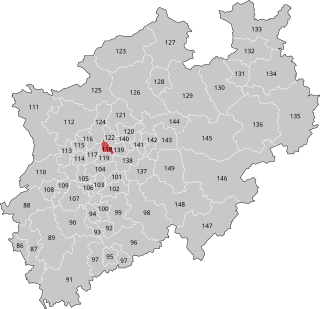
Essen II is an electoral constituency represented in the Bundestag. It elects one member via first-past-the-post voting. Under the current constituency numbering system, it is designated as constituency 118. It is located in the Ruhr region of North Rhine-Westphalia, comprising the northeastern part of the city of Essen.

Bottrop – Recklinghausen III is an electoral constituency represented in the Bundestag. It elects one member via first-past-the-post voting. Under the current constituency numbering system, it is designated as constituency 124. It is located in the Ruhr region of North Rhine-Westphalia, comprising the city of Bottrop and western parts of the Recklinghausen district.

Herne – Bochum II is an electoral constituency represented in the Bundestag. It elects one member via first-past-the-post voting. Under the current constituency numbering system, it is designated as constituency 140. It is located in the Ruhr region of North Rhine-Westphalia, comprising the city of Herne and the eastern part of the city of Bochum.

Recklinghausen II is an electoral constituency represented in the Bundestag. It elects one member via first-past-the-post voting. Under the current constituency numbering system, it is designated as constituency 121. It is located in the Ruhr region of North Rhine-Westphalia, comprising the northern and eastern part of the Recklinghausen district.
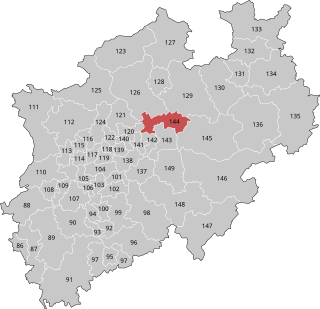
Hamm – Unna II is an electoral constituency represented in the Bundestag. It elects one member via first-past-the-post voting. Under the current constituency numbering system, it is designated as constituency 144. It is located in the Ruhr region of North Rhine-Westphalia, comprising the city of Hamm and the northern part of the district of Unna.

Neuss I is an electoral constituency represented in the Bundestag. It elects one member via first-past-the-post voting. Under the current constituency numbering system, it is designated as constituency 107. It is located in western North Rhine-Westphalia, comprising the southeastern part of the district of Rhein-Kreis Neuss.

Wesel I is an electoral constituency represented in the Bundestag. It elects one member via first-past-the-post voting. Under the current constituency numbering system, it is designated as constituency 112. It is located in the Ruhr region of North Rhine-Westphalia, comprising most of the district of Wesel.

Duisburg I is an electoral constituency represented in the Bundestag. It elects one member via first-past-the-post voting. Under the current constituency numbering system, it is designated as constituency 114. It is located in the Ruhr region of North Rhine-Westphalia, comprising the southern part of the city of Duisburg.
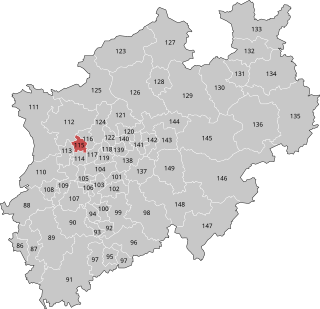
Duisburg II is an electoral constituency represented in the Bundestag. It elects one member via first-past-the-post voting. Under the current constituency numbering system, it is designated as constituency 115. It is located in the Ruhr region of North Rhine-Westphalia, comprising the northern part of the city of Duisburg.
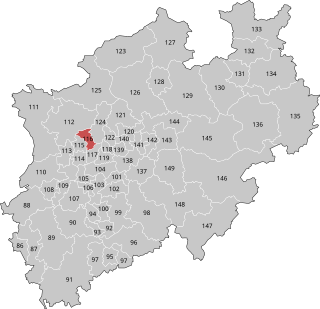
Oberhausen – Wesel III is an electoral constituency represented in the Bundestag. It elects one member via first-past-the-post voting. Under the current constituency numbering system, it is designated as constituency 116. It is located in the Ruhr region of North Rhine-Westphalia, comprising the city of Oberhausen and a small part of the Wesel district.
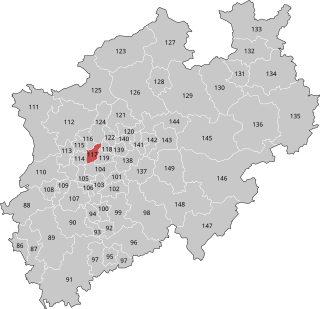
Mülheim – Essen I is an electoral constituency represented in the Bundestag. It elects one member via first-past-the-post voting. Under the current constituency numbering system, it is designated as constituency 117. It is located in the Ruhr region of North Rhine-Westphalia, comprising the city of Mülheim and northwestern parts of the city of Essen.

Essen III is an electoral constituency represented in the Bundestag. It elects one member via first-past-the-post voting. Under the current constituency numbering system, it is designated as constituency 119. It is located in the Ruhr region of North Rhine-Westphalia, comprising the southern part of the city of Essen.

Recklinghausen I is an electoral constituency represented in the Bundestag. It elects one member via first-past-the-post voting. Under the current constituency numbering system, it is designated as constituency 120. It is located in the Ruhr region of North Rhine-Westphalia, comprising the southeastern part of the Recklinghausen district.
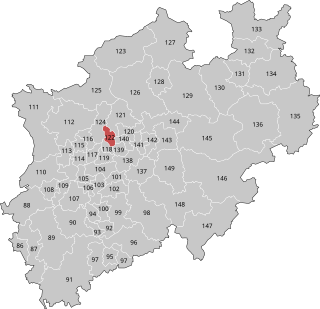
Gelsenkirchen is an electoral constituency represented in the Bundestag. It elects one member via first-past-the-post voting. Under the current constituency numbering system, it is designated as constituency 122. It is located in the Ruhr region of North Rhine-Westphalia, comprising the city of Gelsenkirchen.

Minden-Lübbecke I is an electoral constituency represented in the Bundestag. It elects one member via first-past-the-post voting. Under the current constituency numbering system, it is designated as constituency 133. It is located in eastern North Rhine-Westphalia, comprising most of the Minden-Lübbecke district.

Hagen – Ennepe-Ruhr-Kreis I is an electoral constituency represented in the Bundestag. It elects one member via first-past-the-post voting. Under the current constituency numbering system, it is designated as constituency 137. It is located in the Ruhr region of North Rhine-Westphalia, comprising the city of Hagen and the southern part of the Ennepe-Ruhr-Kreis district.

Ennepe-Ruhr-Kreis II is an electoral constituency represented in the Bundestag. It elects one member via first-past-the-post voting. Under the current constituency numbering system, it is designated as constituency 138. It is located in the Ruhr region of North Rhine-Westphalia, comprising the northern part of the Ennepe-Ruhr-Kreis district.

Bochum I is an electoral constituency represented in the Bundestag. It elects one member via first-past-the-post voting. Under the current constituency numbering system, it is designated as constituency 139. It is located in the Ruhr region of North Rhine-Westphalia, comprising the western and central part of the city of Bochum.

Dortmund I is an electoral constituency represented in the Bundestag. It elects one member via first-past-the-post voting. Under the current constituency numbering system, it is designated as constituency 141. It is located in the Ruhr region of North Rhine-Westphalia, comprising the western part of the city of Dortmund.
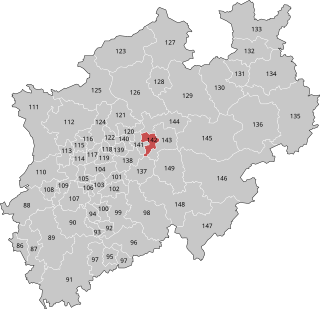
Dortmund II is an electoral constituency represented in the Bundestag. It elects one member via first-past-the-post voting. Under the current constituency numbering system, it is designated as constituency 142. It is located in the Ruhr region of North Rhine-Westphalia, comprising the eastern part of the city of Dortmund.




















